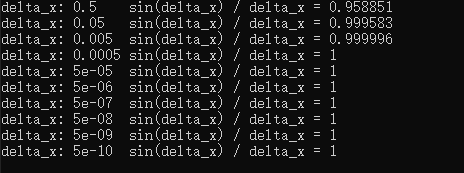求导四则运算和三角函数求导

本节重点讲解了两个三角函数求导公式的证明:
f
′
(
sin
(
x
)
)
=
cos
(
x
)
f'(\sin(x)) = \cos(x)
f′(sin(x))=cos(x)
f
′
(
cos
(
x
)
)
=
−
sin
(
x
)
f'(\cos(x)) = -\sin (x)
f′(cos(x))=−sin(x)
其中用到了两个辅助证明的公式:
lim
Δ
x
→
0
cos
Δ
x
−
1
Δ
x
=
0
\lim_{\Delta{x} \rightarrow 0} \frac{\cos \Delta{x} - 1}{\Delta{x}}=0
Δx→0limΔxcosΔx−1=0
lim
Δ
x
→
0
sin
Δ
x
Δ
x
=
1
\lim_{\Delta{x} \rightarrow 0} \frac{\sin \Delta{x}}{\Delta{x}}=1
Δx→0limΔxsinΔx=1
编程证明一下上面两个式子
证明第一个式子:
#include <cmath>
#include <iostream>
int main()
{
double delta_x = 0.5;
for (int i = 0; i < 10; ++i, delta_x /= 10.0) {
double rst = (cos(delta_x) - 1) / delta_x;
std::cout << "delta_x: " << delta_x << "\t(cos(delta_x) - 1) / delta_x = " << rst << std::endl;
}
return 0;
}
输出:

证明第二个式子:
#include <cmath>
#include <iostream>
int main()
{
double delta_x = 0.5;
for (int i = 0; i < 10; ++i, delta_x /= 10.0) {
double rst = sin(delta_x) / delta_x;
std::cout << "delta_x: " << delta_x << "\tsin(delta_x) / delta_x = " << rst << std::endl;
}
return 0;
}
输出:























 2481
2481











 被折叠的 条评论
为什么被折叠?
被折叠的 条评论
为什么被折叠?










